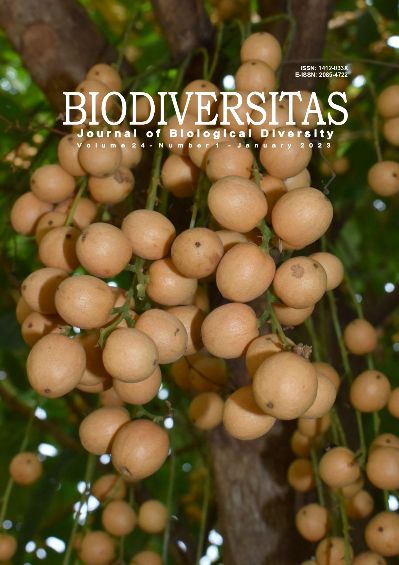Vegetation composition, diversity, stand structure and carbon stock of a dry evergreen montane forest of Lendikinya forest reserve in Tanzania
##plugins.themes.bootstrap3.article.main##
Abstract
Abstract. Mwaluseke ML, Mwakalukwa EE, Maliondo SMS. 2023. Vegetation composition, diversity, stand structure and carbon stock of a dry evergreen montane forest of Lendikinya forest reserve in Tanzania. Biodiversitas 24: 551-562. There is limited information on woody plant diversity and vegetation patterns in African dry forests, particularly in East Africa, and hence increasing the interests in understanding species composition, diversity, and structural attributes of catchment forest reserves found in Tanzania. Moreover, tree species composition, species richness, and carbon stock are not well documented in most montane forests in the region, apart from Ethiopia. Their potential in terms of carbon storage is also important for understanding their productivity and the extent to which they can be used in mitigating the effects of climate change. This study assessed vegetation composition and diversity, stand structure and potential carbon stocks of Lendikinya Forest Reserve, a dry evergreen montane forest located in Monduli District in Tanzania. A total of 56 concentric circular plots with subplots of 2 m, 5 m, 10 m, 15 m and 20 m radii were used to collect woody species data on standing trees and stumps across the entire forest of 3,689 ha. A total of 79 species belonging to 36 families were identified. Drypetes natalensis (9.2%), Diospyros abyssinica (7.1%) and Dombeya rotundifolia (6.5%) were the most important species as per the Importance Value Index (IVI). The diversity indices have indicated the forest reserve to have a high diversity of woody species. Stand structure comprises 1,398 ± 679 stems ha-1, basal area of 11.42 ± 5.41 m2ha-1and standing volume of 54.47 ± 24.1 m3ha-1 while the mean carbon stocks were 16.04 ± 7.7 t C ha-1. The alarming disturbances stress the urgent need for increased conservation efforts in order to protect the existing biodiversity and increase carbon storage and enhance water conservation in the reserve.

